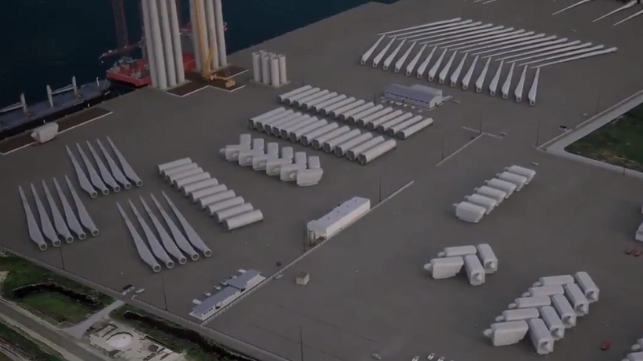EU Needs to Invest $8B in Port Infrastructure to Support Offshore Wind

Europe’s ports must play a critical role if the European Union is going to achieve its ambitious goals for wind power generation. According to a new report released by WindEurope, Europe’s ports must expand and add new infrastructure to support the development of offshore wind.
The European wind trade association is urging the European Commission to develop a port strategy that recognizes the role ports will play in achieving the goals to reduce greenhouse gas emissions and their long-term role in the future of renewable energy. The group is calling for a nearly $8 billion investment in port infrastructure to support the planned offshore wind expansion from now to 2030.
“Ports are essential for offshore wind. They’re a vital part of the supply and logistics chain that’s needed for the installation, assembly, operation, and maintenance of offshore wind farms,” says Giles Dickson, CEO of WindEurope. “We can’t expand offshore without also expanding and upgrading Europe’s port infrastructure.”
As part of its plan to achieve climate neutrality, the EU is projecting a 25 times increase in the amount of power generated through offshore wind. By 2030, the plan calls for the power generated from offshore wind farms to grow from 25 GW to over 110 GW. The goal is to reach more than 400 GW by 2050. While numerous programs are underway to develop offshore wind farms across Europe, the trade group highlights the common factor in all the efforts will be ports.
Europe cannot deliver its plans for offshore wind development without investments in port infrastructure, says WindEurope. The offshore wind industry needs the space that ports provide along with heavy-loading quaysides and deep berths that will play critical roles both in the supply chain and the infrastructure for the development of hydrogen. Ports they point out are a magnet for much of the supply chain with all the turbines, equipment, and personnel transported through ports. They also highlight that ports are the future base for the operation and maintenance of offshore wind farms.
While the development of port infrastructure is typically a matter for local, regional, and national authorities, WindEurope believes given the strategic importance of ports to fulfilling the EU’s goals for offshore renewable energy, the European Commission should develop a strategy for the development of port infrastructure. Their report outlines the needed upgrades and expansion to port infrastructure while also calling on the EU to develop the financing mechanisms required to support the required investments.
Longer-term, the group also highlights the role ports will play in green energy. Once the wind farms are in service, ports become natural hubs for the hydrogen sector and the future of sustainable energy generation.
“The offshore wind supply chain is often located in or around ports and the ports are then integrated into wider industrial ecosystems,” says Dickson. “Port will play a key role in the decarbonization of e.g. chemicals and refineries in coastal industrial clusters – through the renewable energy for which they serve as a hub,” highlights the report.
Over the next decade, they forecast that ports will also play a key role in upscaling Europe’s renewable hydrogen infrastructure. They’re a natural location for electrolyzers. WindEurope highlights that many electrolysis projects at ports are already being developed. Renewable hydrogen produced in ports can be stored locally and consumed in the local industrial ecosystem. It can also be used as a fuel for heavy-duty transport or further processed to ammonia for use in shipping.
But ports can only deliver those services if they make significant investments to upgrade and expand their infrastructure. While their analysis shows the need for the $8 billion investment, WindEurope concludes that this investment could be paid back in just five years. They highlight the significant savings wind power will create for electricity consumers and society as a whole along with the ability to make real progress in the efforts to address climate change.
